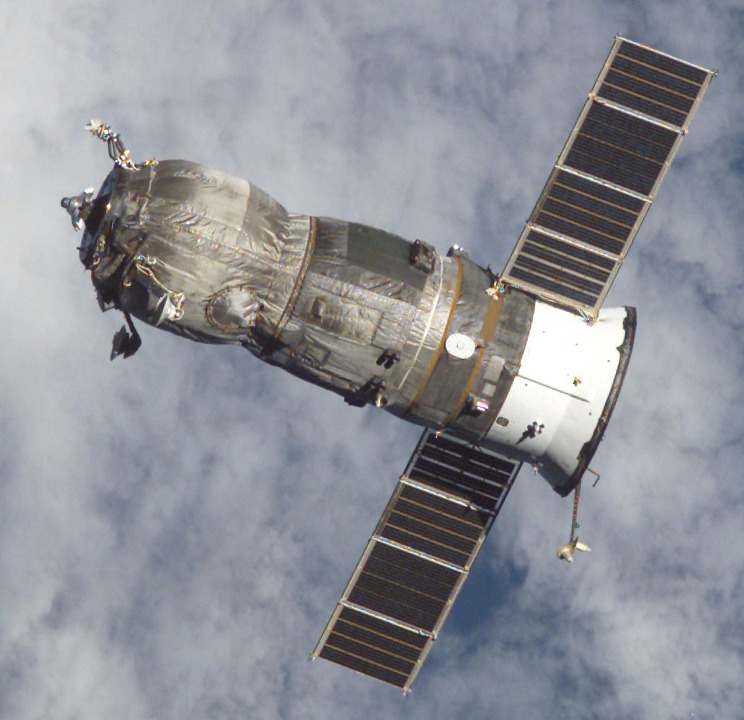Progress-M on:
[Wikipedia]
[Google]
[Amazon]
Progress-M (, GRAU indices 11F615A55 and 11F615A60), also known as Progress 7K-TGM, is a  The first forty three Progress-M spacecraft were used to resupply
The first forty three Progress-M spacecraft were used to resupply
Russia
Russia, or the Russian Federation, is a country spanning Eastern Europe and North Asia. It is the list of countries and dependencies by area, largest country in the world, and extends across Time in Russia, eleven time zones, sharing Borders ...
n, previously Soviet
The Union of Soviet Socialist Republics. (USSR), commonly known as the Soviet Union, was a List of former transcontinental countries#Since 1700, transcontinental country that spanned much of Eurasia from 1922 until Dissolution of the Soviet ...
spacecraft which is used to resupply space station
A space station (or orbital station) is a spacecraft which remains orbital spaceflight, in orbit and human spaceflight, hosts humans for extended periods of time. It therefore is an artificial satellite featuring space habitat (facility), habitat ...
s. It is a variant of the Progress
Progress is movement towards a perceived refined, improved, or otherwise desired state. It is central to the philosophy of progressivism, which interprets progress as the set of advancements in technology, science, and social organization effic ...
spacecraft, originally built in the late 1980s as a modernised version of the Progress 7K-TG spacecraft, using new systems developed for the Soyuz-T
The Soyuz-T (, ''Union-T'') spacecraft was the third generation Soyuz spacecraft, in service for seven years from 1979 to 1986. The ''T'' stood for transport (, ). The revised spacecraft incorporated lessons learned from the Apollo Soyuz Test ...
and Soyuz-TM spacecraft. The 11F61560 variant incorporated further modernisation, with digital flight control systems replacing the earlier analogue ones. The older 11F615A55 spacecraft outlived the newer 11F615A60. The final Progress-M, Progress-M-UM, was launched on 24 November 2021.
 The first forty three Progress-M spacecraft were used to resupply
The first forty three Progress-M spacecraft were used to resupply Mir
''Mir'' (, ; ) was a space station operated in low Earth orbit from 1986 to 2001, first by the Soviet Union and later by the Russia, Russian Federation. ''Mir'' was the first modular space station and was assembled in orbit from 1986 to ...
, with subsequent spacecraft flying to the International Space Station
The International Space Station (ISS) is a large space station that was Assembly of the International Space Station, assembled and is maintained in low Earth orbit by a collaboration of five space agencies and their contractors: NASA (United ...
. , eighty seven spacecraft have been launched, with sixty seven using the older model, and twenty using the newer version. Launches of the 11F615A60 are continuing. One 11F615A60, Progress M-12M
Progress M-12M (), identified by NASA as Progress 44P, was an uncrewed Progress (spacecraft), Progress spacecraft that was lost in a launch failure on 24 August 2011, at the start of a mission to resupply the International Space Station. It was ...
, was lost in a launch failure in August 2011. Progress M-27M was launched on 28 April 2015 but communication with the vessel was lost soon after. With vehicle control lost, it is expected to destructively re-enter due to orbital decay
Orbital decay is a gradual decrease of the distance between two orbiting bodies at their closest approach (the periapsis) over many orbital periods. These orbiting bodies can be a planet and its satellite, a star and any object orbiting it, or ...
.
Two Progress M spacecraft, M-14 and M-38, were modified to carry VDU attitude control systems to the Mir
''Mir'' (, ; ) was a space station operated in low Earth orbit from 1986 to 2001, first by the Soviet Union and later by the Russia, Russian Federation. ''Mir'' was the first modular space station and was assembled in orbit from 1986 to ...
space station.
The Progress M1 is a derivative of the Progress M, optimized to carry more fuel, at the expense of dry cargo and water. It entered service in 2000, and was retired in 2004. A modernised version, incorporating the upgrades made to the Progress M 11F615A60 was scheduled to enter service in 2011, however this was cancelled before it made its first flight.
The upgraded Progress MS spacecraft flew for the first time in December 2015.
See also
* Comparison of orbital spacecraft *Automated Transfer Vehicle
The Automated Transfer Vehicle, originally Ariane Transfer Vehicle or ATV, was an expendable automated cargo spacecraft, cargo spacecraft developed by the European Space Agency (ESA), used for space cargo transport in 2008–2015. The ATV desi ...
* Cygnus spacecraft
Cygnus is an Expendable launch system, expendable American Uncrewed spacecraft, automated cargo spacecraft designed for International Space Station (ISS) resupply missions. It was initially developed by Orbital Sciences Corporation with financia ...
* SpaceX Dragon
Dragon is a family of spacecraft developed and produced by American private space transportation company SpaceX.
The first variant, later named SpaceX Dragon 1, Dragon 1, flew 23 cargo missions to the International Space Station (ISS) between ...
* H-II Transfer Vehicle
The H-II Transfer Vehicle (HTV), also called , is an Expendable launch system, expendable Japanese Cargo spacecraft, automated cargo spacecraft designed for International Space Station (ISS) resupply missions, particularly the Kibo (ISS module ...
References
External links
* * * {{Soyuz variants Progress (spacecraft)